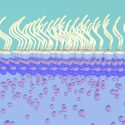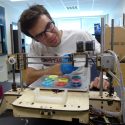SEMATECH donates cutting-edge lab equipment to UW-Madison
Students in Mechanical Engineering Professor Roxann Engelstad‘s lab, sought after in industry for their problem-solving experience, now can graduate even more well-versed in cutting-edge technology.
Thanks to a gift from semiconductor research consortium SEMATECH, the lab now boasts a Zygo frequency-shifting interferometer, a device typically used to measure lithographic glass substrates used in computer chip manufacturing. The interferometer performs wave diagnostics and optical measurements on the nanometer scale, or billionths of a meter. The instrument combines two or more light waves to create interference. Interference patterns can show the shape of the part under test, such as surface flatness.
Chris Van Peski, who recently retired as a senior member of the technical staff at SEMATECH, used the instrument for nanolithography research. Upon his retirement, SEMATECH decided that the industry would best be served if the equipment were moved to a place where it would be used in a way that would address industry-wide issues. “We chose the Computational Mechanics Center at the University of Wisconsin,” Van Peski explains.
“This is a tremendous gift,” Engelstad says. “It gives the students the opportunity to work with one of the best tools available.”
The system, including the frequency-shifting interferometer, a 12-inch beam expander, a custom-built environmental hood, and numerous pieces of specialized tooling and fixtures specially built for it, would have cost the university more than $500,000. However, Van Peski believes that the benefit to industry is worth far more.
“Roxann has been very effective at getting her students to understand and work on industry problems, so that when they graduate they can hit the ground running,” says Van Peski. “They are at the leading edge of the current research.”
Another factor in the UW–Madison acquisition is the capacity for a stable environment. Vibrationally-isolated floors were installed during the 2007 renovation of the Mechanical Engineering building. The interferometer measures on the nanoscale and runs over a period of several seconds. “Any vibration during that time degrades the data,” says Van Peski. “Having a vibration-free environment is key.”
The system was immediately put to use in its new home. “The students are already using the new tool to investigate the proper procedure to measure extreme ultraviolet lithography mask substrates for the next generation of computer chips,” says Engelstad.
Tags: business, computers, engineering, gifts, nanotechnology



